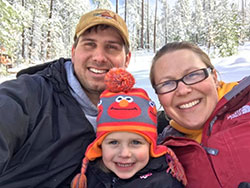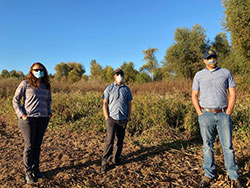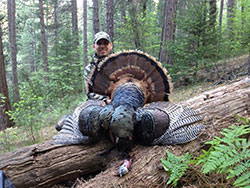Brian Olson is the CDFW’s Comprehensive Wetland Habitat Program coordinator. He leads a four-person team tasked with preserving, restoring and enhancing California’s wetlands – on both public and private land – for the benefit of wildlife. Born in Redding and raised in Weaverville, Brian holds a bachelor’s degree in wildlife, fisheries and conservation biology from UC Davis and a master’s degree in avian sciences, also from UC Davis. He joined CDFW in his current role in 2015. He is based in West Sacramento.
Brian Olson holds up a Trinity Lake smallmouth bass. Brian grew up in Weaverville, Trinity County.

Brian, his wife, Ami, and their daughter, Juniper. Ami Olson also works for CDFW as the coordinator of the Regional Conservation Investment Strategies Program (RCIS), which encourages regional conservation planning in restoring, enhancing and reconnecting wildlife habitat.

CDFW’s Comprehensive Wetland Habitat Program team assess habitat at Little Dry Creek, part of CDFW’s Upper Butte Basin Wildlife Area. From left, Environmental Scientist Kelsey Navarre, Environmental Scientist Jeff Kohl, and Brian Olson. Not pictured is retired annuitant Bill Cook, the former manager of the Los Banos Wildlife Area.

Brian Olson shows off the results of a successful turkey hunt.
CDFW Photos
Brian Olson is the CDFW’s Comprehensive Wetland Habitat Program coordinator. He leads a four-person team tasked with preserving, restoring and enhancing California’s wetlands – on both public and private land – for the benefit of wildlife. Born in Redding and raised in Weaverville, Brian holds a bachelor’s degree in wildlife, fisheries and conservation biology from UC Davis and a master’s degree in avian sciences, also from UC Davis. He joined CDFW in his current role in 2015. He is based in West Sacramento.
Why do we need to manage wetlands in the first place?
We have a lot fewer than what we’ve had in the past and still have a lot of wildlife that depend upon them. Over the past 150 years, we’ve lost about 95 percent of our wetlands in the Central Valley. Thus the relatively few remaining wetlands that we have are important, and we need to manage them in a way that maximizes their value for waterfowl and other wetland-dependent species.
How do you go about improving wetlands for CDFW?
Our primary role – and the reason for the creation of our program – is to serve as a mechanism for CDFW to accomplish the wetland protection, restoration, enhancement and management objectives of the Central Valley Joint Venture, which is a coalition of state, federal and private entities that helps guide conservation actions for this region. Our program is designed to work with both private and public wetland managers. After this fall, we’ll have about 85,000 acres of private lands under management agreements where we compensate landowners in one form or another to manage their lands in accordance with plans we put together with them. And then we also work with another 150,000 acres of public lands. That includes all of our major wetland wildlife areas throughout the state. I look at us as being consultants of sorts, helping wetland managers with management plans and annual work plans, helping them with wetland projects, and helping them with funding and just wetland and upland management issues in general.
Our ability to help folks manage wetlands relies heavily on a network of partnerships that have been developed over decades, many of which pre-date my time here at the department. Whether that’s CDFW wildlife area managers, private landowners, other government agencies such as the U.S. Fish and Wildlife Service, nonprofits like Ducks Unlimited and California Waterfowl and others like the California Rice Commission, Audubon, UC Davis, resource conservation districts and mosquito and vector control districts. We couldn’t do any of the things we do without the help of our many partners.
Why would a private property owner want to partner with CDFW on wetland management?
First, they are getting a free wetland consultant for their property. Better yet, they are getting a wetland consultant that pays them to do things on their property that enhances its value for wildlife. Our California Waterfowl Habitat Program (aka the Presley Program) and the California Winter Rice Habitat Incentive Program both offer landowners an annual incentive payment to manage their land in accordance with cooperatively developed management plans.
How much money are we talking about here?
The amount we pay landowners depends on the type of habitat they provide. On a per-acre basis it ranges between $15 and $60 per acre. We had $10 million available for our last round of funding for the Presley Program. That money came from Proposition 68, a voter-approved bond measure.
What are some of the biggest challenges you are facing these days?
For our public areas, it is largely funding and capacity for ongoing management. We’ve got a lot of land to manage with limited resources. For private land, it’s also largely funding. We had about double the properties apply for this last Presley solicitation than what we had funding for, so there is a significant opportunity to expand. Recruitment of wetland managers is also challenging. There doesn’t seem to be as many folks interested in doing this type of work – or at least their applications aren’t making their way to us when positions become available.
Waterfowl season is well underway. What can hunters expect, habitat-wise, when they head out to hunt the different public areas?
In the Sacramento and San Joaquin valleys, things are looking pretty good. Initially, it wasn’t looking like we were going to have the water we needed to manage wetlands optimally in these basins, but it ended up being OK, with reservoir inflow being just barely high enough in the spring for us to receive an adequate water supply. Due to this, both our seasonal and semi-permanent wetlands in these areas look pretty good this year. The public wetlands up in northeastern California don’t have the water storage that we have to work with in the Central Valley and are much more reliant on natural hydrology. These areas didn’t get as much water as we would have liked and are not looking as good this year.
Regardless of location, it was a tough year to do wetland management. As someone who hunts the wildlife areas myself, I want to mention how much I appreciate all the additional effort staff from our wildlife areas and the U.S. Fish and Wildlife Service put in this year to make sure we could access these wildlife areas and the national wildlife refuges. They put in safeguards and physical distancing measures, and came up with a COVID-19 plan that complied with state guidance so that public areas would remain open and folks could come out and enjoy the resource and these beautiful places.
California’s population of wild mallards has declined. Is there anything you can do from a wetland management perspective to help mallards specifically?
The focus of wetland management in California tends to be on seasonal wetlands in the fall and winter – and for good reason. We’ve got the highest concentration of wintering waterfowl anywhere in the world. But for certain species such as mallards, gadwall and cinnamon teal, we’ve got to be thinking about life cycle needs outside of wintering habitat. Close to 70 percent of the harvested mallards in this state are born and raised in California, so if we want more mallards, then we need to focus on growing them in California. One of the things that we can do to help is to provide semi-permanent or reverse-cycle wetlands where water is out there at a different time than these seasonal wetlands. It’s important to have that water out on the landscape from late March, early April through July. Getting this habitat on the ground has become more of a priority for the Central Valley Joint Venture and, as a result, it was a big part of this last Presley solicitation. Private properties that were willing to provide it received extra points in the scoring process, and we offered a higher incentive payment to private landowners to provide that type of habitat.
And why is wetland habitat from March through July so important?
For ducks, it’s primarily for duckling survival. Statewide, we are pretty limited on brood-rearing habitat. It’s particularly important, especially early on in the brood-rearing period for waterfowl, to have productive wetlands out there. It’s critical for brood survival and super-critical for other wetland-dependent species like tricolored blackbirds. I’d argue the biggest benefit of having this type of wetland on the landscape is for other wetland-dependent species. These spring and summer flooded wetlands are some of the most species-diverse wetlands we have and are absolutely critical to many threatened species like giant garter snakes and tricolored blackbirds.
What first brought you to CDFW and what keeps you here?
I love managing habitat. It’s what I think about all the time, regardless of whether I’m working or not. Prior to CDFW, I was managing a fairly large private duck club with a few thousand acres of property in the Sacramento Valley. It was awesome, but I didn’t have the connection to our public lands that I wanted. I think what brought me to the department was my daughter being born. She’s 5 now and I wanted to preserve as much of this resource and opportunity for her as I could.
Hunting license sales are up in California this season and we have a lot of new hunters out there who might want to give duck hunting a try. What is it you love about duck hunting that you could share with them?
I started duck hunting when I was 7, but what really got me got me addicted to ducks and duck hunting was my first trip to the Sacramento Valley. When you get several million birds in one place, it’s a pretty awesome spectacle. It’s not really a describable feeling; you have to get out there and experience it. Even if folks don’t want to hunt but just want to go sit in the marsh, it’s pretty special.
Away from work, where are we likely to find you?
In a normal year, probably hiking, hunting, or fishing with friends and family. The specific activity really depends on the time of year. If it’s spring, I’m probably turkey hunting or fishing. If it’s summer, I’m probably fishing, camping, or backpacking. In fall, I’m usually deer or elk hunting, and in winter, I’m likely duck hunting, though I don’t hunt nearly as much as I used to. One of the great things about living in California is that there are a ton of outdoor activities to do year-round.